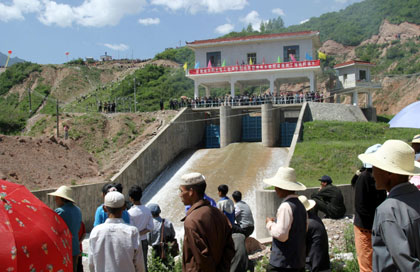As the walkthrough fountain pushes a jet of water more than five stories into
the air, townsfolk gather at its edge and children scuttle through the spray.
This could be a scene from any town in China, but this fountain is special
because it's in Dongxiang, high on the Yellow-Earth Plateau, in Northwest
China's Gansu Province.
Dongxiang has an annual rainfall of 350 millimetres, but four times that much
water evaporates in the same amount of time, shaping the topography to resemble
the wrinkled face of an old man.

Local villagers flock
to see the historic moment when the Nanyang Irrigation Pipeline Project
starts to pump water into the parched land in this July 2, 2004 photo.
[newsphoto] |
The county is one of the poorest in China, and the main culprit is
unrelenting drought.
Scientists say it was different 2.6 million years ago.
As fossils of tigers in the museum across the street from the fountain
indicate, this land used to be verdant and fertile. Then, some kind of
apocalypse wiped out most of the species and transformed the landscape into
giant pancakes of arid soil. The few patches of farmland left on the hillside
are totally vulnerable to the whims of Mother Nature.
Ironically, the county is bordered by several rivers, including one of
China's greatest the Yellow River. Villagers had to haul buckets of water on
donkeys and shoulder poles and trek dozens of kilometres uphill to bring it
home.
"Villagers would use the water to first wash vegetables and rice, and then
wait until the sediment is deposited, boil the cleaner part for drinking and use
the rest for laundry," said Ma Weigang, county magistrate. "What it left was
then poured on whatever is grown in the land.
"The old saying 'each plot of land feeds its residents' is invalid in our
county," Ma added.
The residents on this barren and dusty terrain are mostly of one ethnicity
Dongxiang, or Sarta, as they call themselves. Their ancestors were women and
craftsmen captured by Genghis Khan (1162-1227) on his conquest in Central Asia.
They speak a language that has no written form.
In 1992, then-Vice-Premier Tian Jiyun visited the county and approved a
project that would make the water surrounding the county available to those
living in its 1,750 ridges and 3,083 valleys.
On a separate inspection, Premier Wen Jiabao said that it would be worthwhile
to invest hundreds of millions to solve the water shortage for a whole race.
In 1995, the Nanyang Irrigation Pipeline Project took off. Nine years later,
the main artery and some secondary routes were completed, pumping water to the
parched land.
The 560-million-yuan (US$70 million) project consists of 56.7 kilometres of
main artery. This branches into four secondary conduits totalling 40 kilometres,
then bifurcating into 14 pipelines totalling 159 kilometres. Along the routes
are 24 aqueducts that irrigate around 8,000 hectares.
Half of that area lies in Dongxiang County.
When the project is fully completed by mid-2007, about 120 villages and
150,000 residents will benefit.
"As of now, about 80 per cent of our people no longer
suffer from an acute shortage of water," Ma said. "This figure will be raised to
90 per cent next year."